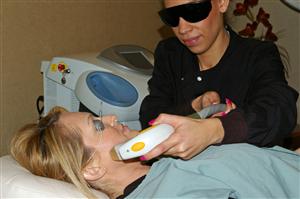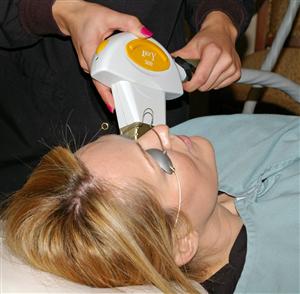As Father Time steals another year, 2015 is a good year to cheat him out of leaving his imprint on our face. Science comes to our aid once again as we sort out the best way to turn back the clock. This year, consider getting three Intense Pulse Light (IPL) treatments each separated by four to six weeks. IPL is a broad band of noncoherent light with wavelengths from 400 to 2,000 nm (depending on manufacturer). It is also known as Broad Band Light (BBL).
The treatment is performed in a physician’s office by trained medical personnel who are supervised by the physician. No anesthesia is necessary. The light treatments can feel hot to the skin and, for that reason, many offices also provide a chiller which blows cool air on the skin and minimizes the discomfort of the treatment. The side effects are minimal with some redness of the skin that can be covered with makeup so that you can return to work. Sometimes there can be swelling that lasts a day or two and if you have a lot of brown spots those can get crusty after a couple of days and take up to a week to completely peel off but again can be covered with makeup.


Why IPL
 Anne Lynn Chang MD, a professor of Dermatology at Stanford, published an article entitled “Rejuvenation of gene expression pattern of aged human skin by broad band light treatment: A pilot study.” J Invest Dermatol. 2013;133;394-402. Dr Chang, has an interest in treating aging skin, “understanding why skin ages and learning how to maintain healthy skin into advanced age—then applying these insights clinically to improve skin function…”.
Anne Lynn Chang MD, a professor of Dermatology at Stanford, published an article entitled “Rejuvenation of gene expression pattern of aged human skin by broad band light treatment: A pilot study.” J Invest Dermatol. 2013;133;394-402. Dr Chang, has an interest in treating aging skin, “understanding why skin ages and learning how to maintain healthy skin into advanced age—then applying these insights clinically to improve skin function…”.
She notes that physicians using IPL for facial treatments (photofacials), have achieved good cosmetic results. Patients saw a decrease in age spots, spider veins, redness, and even some smoothing of wrinkles. She wanted to determine if the improvement was more than just superficial but possibly even affecting the genes that are responsible for aging. Her team treated the forearms of five healthy prime women (>50 years old) and took biopsies of the treated and untreated skin and compared them to the biopsies of forearm skin from our younger sisters (<30 years old). Treatments involved three monthly IPL sessions using broad band light (560-1,200nm). The treated skin not only looked better but the genes also looked more like the genes of the under 30-year-old skin!
IPL treatment alters skin-aging genes
 In this preliminary study, Dr Chang, showed that broad band light treatment promotes the gene expression pattern of young skin. The exact mechanism by which wavelengths of light actually alter gene expression is not known. BBL technology has been in existence for less than 20 years and hence, long term effects remain to be seen. But, based on the clinical evidence and this study, I will certainly be getting my three treatments this winter to turn back the clock!
In this preliminary study, Dr Chang, showed that broad band light treatment promotes the gene expression pattern of young skin. The exact mechanism by which wavelengths of light actually alter gene expression is not known. BBL technology has been in existence for less than 20 years and hence, long term effects remain to be seen. But, based on the clinical evidence and this study, I will certainly be getting my three treatments this winter to turn back the clock!
Rebecca L. Euwer, M.D.
Dr. Rebecca Euwer is a Board Certified Dermatologist, specializing in cosmetic dermatology.
